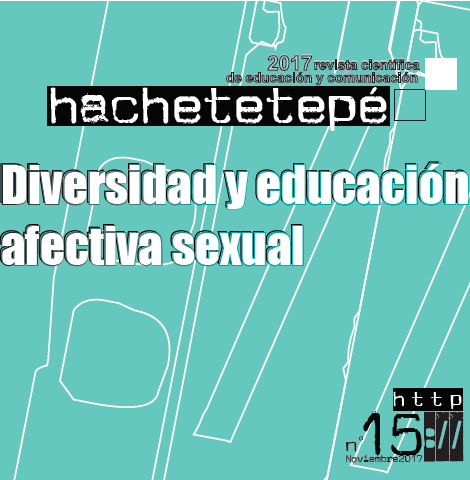“Things kids come up with” or things that boys make to man up? anthropological reflections on age, violence and masculinity
Abstract
With the objective of reducing the relativization and invisibilization of children´s violence in educational contexts that still lays in phrases like “things kids come up with”, in this article we´ll analyze the intersection between age, violence and masculinity and the productive nature of violence -against oneself, amongst peers and the feminized others- in the tension between childhood and adulthood. En educational contexts, the “masculinity exams” amongst peers, full of proscriptions and prescriptions, contributes to the construction of feminized otherness -childs, women and homosexuals- that boys, in their will of "manning up", must reject. Recognizing and tackling this process is an all educational community responsibility, and in these article we offer some tools for that.
Keywords
Downloads
How to Cite
License

This work is licensed under a Creative Commons Attribution-NonCommercial-NoDerivatives 4.0 International License.
Those authors who have published with this journal, accept the following terms:
- They will retain their copyright and guarantee the journal the right to first publication of their work, which will simultaneously be subject to the Creative Commons Attribution License . They may be copied, used, disseminated, transmitted and publicly displayed, provided that the authorship, url, and magazine are cited, and are not used for commercial purposes. No derivative works are allowed.
- They may adopt other non-exclusive license agreements for the distribution of the published version of the work (e.g., deposit it in an institutional telematic archive or publish it in a monographic volume) provided that the initial publication in this journal is indicated.
- Disseminate your work through the Internet (e.g., in institutional telematic archives or on your website) once the manuscript is accepted, which may lead to interesting exchanges and increased citations of the published work. (See The effect of open access).
Hachetetepé. Scientific journal of education and communication does not charge a fee for the submission of manuscripts or for the publication of its articles.
References
Connell, R. W. (1995) Masculinidades. México: PUEG.
Connell, R. W. (2000) Arms and the man: using the new research on masculinity to understand violence and promote peace in the contemporary world. En Breines, I.; Connell, R. W. y otros, Male roles, masculinities and violence. París: UNESCO; 21-33.
Connell, R.W. (2001) Educando a los muchachos: Nuevas investigaciones sobre masculinidad y estrategias de género para las escuelas. Nómadas, 14; 156-171.
de Stéfano Barbero, M. (2017) Hacerse hombre en el aula: masculinidad, homofobia y acoso escolar. Cadernos Pagu, 50; en prensa.
de Stéfano Barbero, M.; Puche Cabezas, L.; Pichardo Galán, J.I. (2015) El compromiso de la investigación social en la construcción de otra escuela posible. Revista Interuniversitaria de Formación del Profesorado, 29(1); 49-60.
Disponible en: http://www.redalyc.org/articulo.oa?id=27439665004
Gardiner, J. K. (2002) Theorizing age with gender: Bly´s boys, feminism, and maturity masculinity. En Gardiner, J. K. (ed.) Masculinity Studies & Feminist Theory. New Directions. New York: Columbia University Press; 90-119.
Gilmore, D. (1999) Hacerse hombre. Concepciones culturales de la masculinidad. Barcelona: Altaya.
Herdt, G. (1987) The Sambia: Ritual and Gender in New Guinea. California: Wadsworth.
Hooks, B. (2004) The Will to Change: Men, Masculinity, and Love. New York: Atria Books.
Kaufman, M. (2009) The construction of masculinity and the triad of men´s violence, en Ore, T. (ed.) The Social construction of difference and inequality: race, class, gender, and sexuality. Boston: McGraw-Hill; 584-598.
Kimmel, M. (1997) Homofobia, temor, vergüenza y silencio en la identidad masculina, en Valdés, T. y Olavarría, J. (eds.) Masculinidad/es. Poder y crisis. Santiago de Chile: ISIS; 49-62.
Messerschmidt, J.W. (2016) Masculinities in the making. From the local to the global. Maryland: Rowman & Littlefield.
Pichardo Galán, J. I.; de Stéfano Barbero, M. (Eds.) (2015) Diversidad sexual y convivencia: Una oportunidad educativa. Madrid: Universidad Complutense de Madrid. Disponible en: https://drive.google.com/file/d/0B6fueHqr--qkMGNHWlkyT1ZOVTA/view
Pichardo Galán, J.I.; de Stéfano Barbero, M. y otros (2015) Abrazar la diversidad: propuestas para una educación libre de homofobia y transfobia. Madrid: Instituto de la Mujer y para la Igualdad de Oportunidades, Ministerio de Sanidad, Servicios Sociales e Igualdad de España. Disponible en: http://www.inmujer.gob.es/actualidad/NovedadesNuevas/docs/2015/Abrazar_la_diversidad.pdf
Sáez Buenaventura, C. (1990) Violencia y proceso de socialización genérica: Enajenación y transgresión, dos alternativas extremas para las mujeres. En Maquieira, V.; Sánchez, C. (Comps.) Violencia y sociedad patriarcal. Madrid: Editorial Pablo Iglesias; 1-18.
Scheper-Hughes, N.; Bourgois, P. (Eds.) (2004) Violence in War and Peace. Oxford: Blackwell
Segal, L. (2007) Slow Motion. Changing Masculinities, Changing Men. New York: Palgrave Macmillan.
Segato, R. (entrevistada) (2017, 3 de junio) La violencia machista es un tema de poder. En L. Iramain. Hijos de 3000. La Plata: FM Universidad de La Plata.
Swain, J. (2005) Masculinities in Education, en Kimmel, M.; Hearn, J. y otros (eds.) Handbook of Studies on Men and Masculinity. Londres: SAGE; 213-229.






